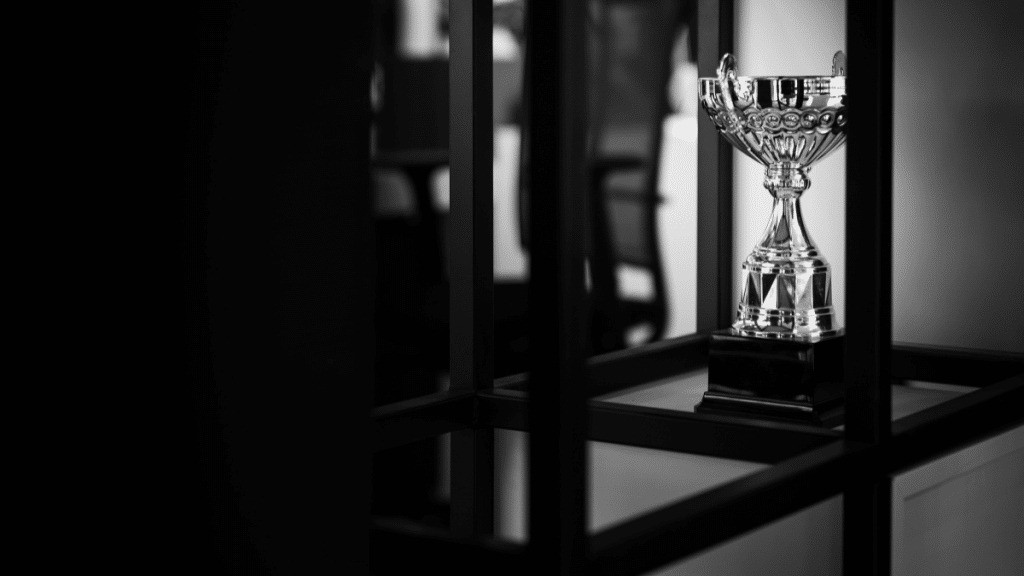We live in an age of instant gratification. Likes appear in milliseconds. We get digital pats on the back all the time these days. Finish a work task? Ding – there’s your badge. Complete an online course? Poof – here’s your certificate in the inbox. These little acknowledgments show up fast and disappear even faster.
But then there’s that trophy on your shelf. You know the one. It doesn’t blink or beep. It just sits there, solid as the day you got it, quietly saying “You did this” every time you glance at it. In our world of here-today-gone-tomorrow recognition, that physical award isn’t just nice to have – it’s almost rebellious. It won’t let you or anyone else forget what you accomplished.
The Paradox of Modern Recognition
Today’s world celebrates speed above all else. We measure success in quick wins and rapid growth metrics. But meaningful accomplishment doesn’t work that way. True mastery, whether in sports, academics, or professional fields, develops through sustained effort – through showing up day after day when no one is watching.
This is where trophies defy modern logic. Unlike digital rewards that vanish into the void, a well-crafted award demands space in the physical world. It gathers dust rather than data. It doesn’t refresh or update. And that’s precisely what makes it powerful.
Why Physical Awards Still Matter
When we hold an actual trophy, something primal and profound happens:
Tangible Validation
There’s weight in every sense of the word – the heft of metal or polished wood in your hands makes the achievement undeniably real in a way pixels never can.
Permanent Recognition
Unlike algorithm-driven praise that disappears in feeds, trophies remain visible years later, often becoming family heirlooms that tell stories across generations.
Silent Motivation
Displayed in an office or home, these awards serve as constant reminders of what’s possible, often inspiring future efforts long after the initial celebration fades.
The Neuroscience of Lasting Rewards
Science explains why physical awards impact us differently than digital ones. Studies in behavioral psychology show that:
Physical objects create stronger memory associations – Our brains are wired to remember what we can touch.
Visible trophies trigger dopamine responses – Seeing them daily reinforces positive behavior patterns.
They satisfy our need for legacy – Humans inherently want to leave markers of their existence.
This explains why athletes often point to their first childhood trophy as the spark that started their journey, or why professionals keep milestone awards on display decades later.
Designing Meaningful Recognition
Not all trophies are created equal. The most impactful share these qualities:
Thoughtful craftsmanship – Materials and design that reflect the significance of the achievement
Personal connection – Engravings or custom elements that tell a specific story
Display-worthy aesthetics – Something recipients genuinely want to keep visible
In corporate settings, well-designed awards reduce turnover by making employees feel valued. In youth programs, they plant seeds of lifelong confidence. The difference lies in moving beyond generic participation trophies to create truly meaningful symbols.
A Countercultural Statement
Choosing to award a physical trophy in our digital age makes a quiet but radical statement:
Some things shouldn’t be fast.
Some achievements deserve to take up space.
Some recognition ought to last.
In boardrooms, these awards remind teams that sustainable success takes time. On children’s shelves, they teach that patience and persistence pay off. For retirees, they become physical chapters of a life’s work.
The Slow Victory
There’s profound wisdom in the way trophies force us to slow down. The ceremony of presentation. The weight in the hands. The careful choosing of its display spot. These rituals create space for genuine appreciation that our swipe-left culture often lacks.
Perhaps what we’re really awarding isn’t just the achievement itself, but the courage to pursue goals that can’t be accomplished in a sprint. The trophy becomes both a finish line and a starting block – honoring where someone has been while pointing toward where they might go next.
In a world obsessed with speed, the most meaningful recognition might just be the kind that stands still.
Final Thought
Next time you’re tempted to send another digital badge, consider the enduring power of physical recognition. A well-chosen trophy doesn’t just mark an achievement – it preserves the story behind it, one that deserves to be told slowly and held onto tightly.
